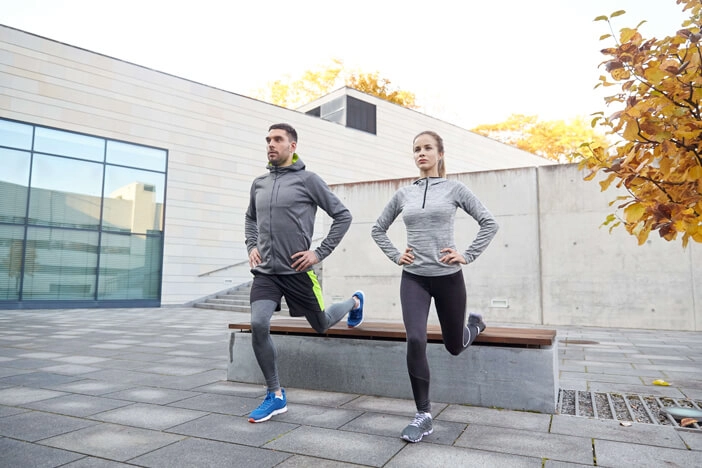Lunges - A great exercise for leg day

Lunges: Targeted muscle groups
Primary muscle groups used:
- Glutes
- Quads
Secondary muscle groups used:
- Hamstrings
Lunges are therefore a great addition to your leg and glutes training.
Correct execution of lunges
Stand with feet waist width apart. To start the exercise take a large step forward. Take care to make your step so that your thighs and lower legs make an angle of 90° with each other when you lunge and that your knees do not protrude over your toes at any point. Both your toes and knees should point forward and your upper body should be upright with you gaze focused straight ahead. Bend your legs until your front thigh is parallel to the ground. Then push backwards with the heel of your front foot to return to the starting position. During the entire exercise, only your legs should move. Your upper body should remain in the same position as at the beginning. Inhale as you move down, and exhale as you move up.
Weight recommendations for lunges

Lunges are performed with your own body weight. To increase the weight you can do the lunges holding dumbbells or perform the exercise with a barbell on your trapezius. Working with weights only makes sense once you have built up a stable core and can do the exercise with perfect control.
Equipment for lunges
You do not need any equipment for lunges.
Variations of lunges

Jumping lunges
Jumping lunges provide a very intensive additional training stimulus. You start with one leg in front, jump up and change legs before landing. Your posture is otherwise the same as with classic lunges. You should pay attention to your torso stability and make sure you land softly.
Backward lunges
The movement of backward lunges is similar to that of forward lunges, the difference is just that you take the step backwards instead of forwards. The same muscle groups are involved, but the knee joint is not quite as involved. Backward lunges are therefore a good alternative for people with knee problems.
Typical errors with lunges

- Leaning forwards: if you bend forward during the movement, you put unnecessary strain on your front knee. Make sure you stay upright!
If you want to learn more about how to integrate lunging into your training, check out our leg and bum training pages.
Frequently asked questions and answers
You can do lunges anytime and anywhere, as they require no equipment. The exercise is suitable for beginners and advanced students alike.
Jumping lunges: Jumping lunges provide a very intensive additional training stimulus. You start with one leg in front, jump up and change legs before landing. Your posture is otherwise the same as with classic lunges. You should pay attention to your torso stability and make sure you land softly.
Backward lunges: The movement of backward lunges is similar to that of forward lunges, the difference is just that you take the step backwards instead of forwards. The same muscle groups are involved, but the knee joint is not quite as involved. Backward lunges are therefore a good alternative for people with knee problems.
Keep your back straight and always do the exercise in a controlled manner.
